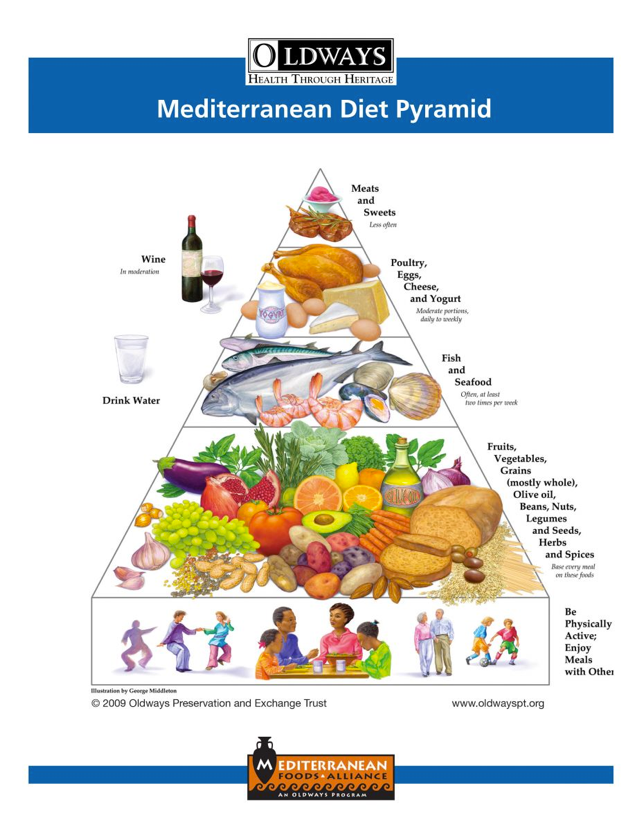[bs_row class=”row”]
[bs_col class=”col-sm-8″]
MEDITERRANEAN DIET
A typical Mediterranean meal pattern puts emphasis on minimally processed foods including produce, fish, whole grains and healthy fats. Those who follow this type of eating plan tend to weigh less, have better blood sugar control, decreased risk of heart disease, depression and dementia.
May is International Mediterranean Diet Month. Take this opportunity to try out this meal pattern that is being recognized as one of the healthiest eating styles in the world:
- Fill your plate with fruits and non-starchy vegetables
- A typical Mediterranean diet includes five to 10 servings per day (1/2 cup cooked, 1 cup raw).
- Pick a variety of colors to get a range of antioxidants, vitamins and minerals.
- A large green salad or stir fry are great ways to get multiple servings in one meal.
- Choose unsaturated fats that provide heart healthy benefits
- Aim for four to six servings per day (1 teaspoon of oil, five olives, 1/8 of an avocado).
- Replace butter and margarines with healthy oils such as olive, canola or walnut when possible.
- Choose olive oil for cooking and baking. Dip bread in olive oil and balsamic vinegar instead of butter.
- Pick seeds, nuts and legumes for fiber and protein
- Eat one serving of legumes two or more times per week (1/2 cup of beans/lentils) and one small serving of nuts daily (1 tablespoon or ~12 almonds).
- Pick lean proteins such as fish and skinless poultry over red meat
- Choose a four-ounce serving of fish (the size of a checkbook) two to three times per week. Salmon and tuna are especially good sources of omega-3 fatty acids which are linked to improved heart health.
- Reserve red meat for a few times per month.
- Eggs are another great source of protein.
- Cook vegetarian once or more per week by building meals around beans.
- Dairy
- Choose one to three servings of dairy per day (1 cup milk or yogurt or 1 ounce of cheese).
- Certain dairy products provide probiotics (healthy bacteria), which provide health benefits. Good options are yogurt, Kefir and fresh cheeses like ricotta.
- If eating yogurt, choose those low in sugar or with no added sugar.
- Whole grains
- Look for 100 percent whole grain or 100 percent whole wheat bread, pasta and tortillas.
- Choose other whole grains such as quinoa, buckwheat, brown rice and oatmeal.
- Eat seasonally
- Boost seasonal produce by taking advantage of farmers markets.
- This will help to increase your variety of produce and range of nutrients.
- Use herbs and spices
- These provide antioxidants and provide flavor without using too much salt.
- Set aside time for your meals
- Rather than rushing through a meal or eating in front of the television, sit at the table and focus on eating slowly and enjoying the full meal.
- In the Mediterranean style, meals with friends and family are fundamental. Relaxed meals focused on quality time spent together help eaters to slow down and enjoy their food.
To find more information: Meet with one of PEAK’s registered dietitians or nutrition experts. To make an appointment, click here.
References:
- Eatingwell.com
- Mayoclinic.org
- Oldwayspt.org[/bs_col][bs_col class=”col-sm-4″]
[bs_well size=”lg” ]
PROBIOTICS: WHAT DO THEY DO?
 Probiotics are big business. Sales of products with the live microorganisms are expected to top $10 billion a year by 2018. However, it’s still unclear exactly what they do. While there is information that praises them as a miracle cure-all, there are other studies that say they really don’t do anything at all.
Probiotics are big business. Sales of products with the live microorganisms are expected to top $10 billion a year by 2018. However, it’s still unclear exactly what they do. While there is information that praises them as a miracle cure-all, there are other studies that say they really don’t do anything at all.
Jean Zancanella, a professor of nutrition with the University of Utah College of Health says the answer is likely somewhere in between.
Read more here.
CAR WINDOWS WON’T PROTECT YOU FROM UV RAYS
 It’s a warm summer day and you’re in the hot seat – the driver’s seat, that is. You may not realize it, but the window separating you from the sun’s rays isn’t doing a great job of truly protecting you.
It’s a warm summer day and you’re in the hot seat – the driver’s seat, that is. You may not realize it, but the window separating you from the sun’s rays isn’t doing a great job of truly protecting you.
The front windshield of your car blocks most of the UVA and UVB radiation coming from the sun, but the driver’s side window may not be pulling its weight.
Read the full story here.
For more expert health news and information, visit healthcare.utah.edu/healthfeed.[/bs_well]
[/bs_col]
[/bs_row]


